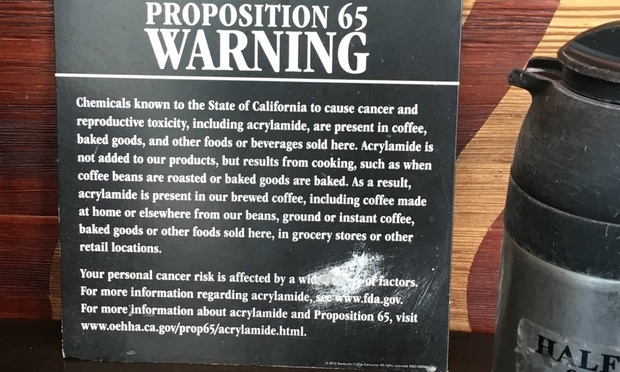Parsing Prop 65: Compliance Hurdles, Liability and More
What are the biggest potential pitfalls for companies under these new rules? How are lawyers advising clients? We caught up with Alston & Bird's Maureen Gorsen, former director of California's Department of Toxic Substances Control, for her perspective.
September 18, 2018 at 03:57 PM
8 minute read

On Aug. 30, new California regulations went into effect revising the product warning information consumers must be given under Proposition 65. That's the 1986 voter-approved initiative mandating alerts about products containing chemicals that may cause cancer or reproductive harm.
The new rules change the wording of the warnings and specify what size they should be on a label. They make businesses choose between “full” and “short-term” warnings. In some instances they require the use of a yellow pictogram with an exclamation point surrounded by a triangle.
They've also created a lot of confusion among manufacturers, suppliers and retailers. The Recorder recently spoke with Alston & Bird partner Maureen Gorsen, former director of California's Department of Toxic Substances Control, about what the new rules actually do and how she's advising her clients on compliance.
The Recorder: So we have these changes surrounding Prop 65. What's the big deal?
 Maureen Gorsen
Maureen GorsenGorsen: Since 1986 when Prop 65 passed, you've seen the warnings everywhere, right? It's been the same warning. No matter where you go the words are the same. Now, under the new regs, if you're going to provide the warning, you have a lot of subjective determinations you need to make. You need to figure out what chemical to list, in what font size, and where you're going to put it.
Now, in addition to figuring out, “OK, do I have to provide the warning or do I not,” you have to decide how to provide the warning. What does the warning need to say? So the big deal is, now you have these subjective, substantive determinations to make in addition to this kind of binary thumbs-up, thumbs-down.
More gray area?
Oh, lots more ambiguity. Lots more choice. Lots more subjectivity.
And maybe lots more areas for attorneys looking for areas to probe for deficiencies?
Correct. Lots more wedge areas where we have differences of opinions. And then we can argue about those differences of opinion. And then we can agree to settle our differences for a sum.
Wasn't there also a shift in liability upstream in the production-to-retail chain?
The retailers have been very good since the beginning of pushing all liability upstream. All the retailers, since they control shelf space, they have so much leverage over suppliers that are just desperate to get shelf space. So they've been able to get really good indemnification terms from vendors upstream.
Now, not only contractually but legally, the liability is shifted upstream so that unless the supplier or vendor does a number of steps, they're automatically “it.” So retailers get an extra layer of protection.
What are the biggest potential pitfalls for companies under these new rules?
I think the biggest pain in the neck for everybody is picking the chemical. Because now you have to name the chemical. And which one do you pick? The regs do not provide any methodology.
When they were proposing the regs in the beginning, years ago, they had a thing called the Dirty Dozen, where the regs were going to say if you have one of these 12 chemicals you have to name it in the warning. But then through the rulemaking process, the Dirty Dozen list fell away and what came in its place was a rule that just says you have to pick one.
OK, which one? If you have multiple, there are toxicologists and chemists that are coming up with methodologies to say, alright, the one with the highest concentration. The one with the highest weight. But who knows whether any of those methods of picking one are going to be found sufficient by a plaintiffs attorney who's trying to create a wedge or by a court.
If you're trying to be uber-cautious could you just list everything?
If you wanted to, you could list away.
Does that provide you any more protection?
Probably not. There's another little thing that's out there and we haven't really seen anyone do anything about it. But in a separate rulemaking package, the state said that if you provide a warning, we have the right to ask for your data and analysis as to why you decided to provide the warning, and we can put it on our website.
They haven't used that reg yet. No one's seen anything. But the more stuff you put in the warning, the more things they could ask you about.
We're several weeks into the new rules. What are you hearing from folks out there?
Well, people have been working on this for a long time. What you did see leading up to Aug. 30 was a lot of letters from various people in the supply chain. So people were sending letters up and down the supply chain. Who's doing the analysis? Who's doing the label? Who's responsible if the label is wrong? That sort of thing.
What are you advising clients about getting in compliance?
There are a lot of decisions that have to be made. Are you going to use the short form or the long form? Which chemical are you going to pick? Because the new rules also require that the warning be given prior to purchase as opposed to prior to exposure, in a lot of cases a label on the product is not going to help you at all.
When people make telephone orders, they're not looking at the product. How, for instance, during a telephone order are you going to give the warning prior to purchase when the person may not be looking at the product? People have had to change their e-commerce sites to generate warnings prior to purchase. So there's been a lot of advice in that area as well.
And then some people are selling industrial products and have very dense catalogs. The warning has to be associated with each product. How are you going to do this, because the words are the same over and over and over—so just how to comply given the different way that people sell things in California.
The regs contemplate certain types of sales and they say, “This is how you do it.” But then there are a lot of other types of sales they don't contemplate. Some people have a standing contract. And then what's happening with purchase orders throughout the year. Is the purchase order the sale every time you sign the contract? So there's been a lot of “How do you comply?” given all the different methods of selling that go on?
What's the outlook for guidance from state regulators or efforts to make changes in the Legislature in the coming year?
So far, they do have a pretty good business guide on their website. They are pretty good at telling you, when you run your scenario by them, whether it seems compliant or it doesn't.
But the bottom line is, the agency that develops the regs is not the agency that enforces this. It's enforced by plaintiffs attorneys. And the agency, you could come to very reasonable agreement with them as to OK, the regs don't address this but they require this, that and the other thing given this set of facts and this is how we're thinking about doing it. And they'll be like, OK, that sounds good, let's try that.
You can come to a wonderful agreement with them. However, that's not the game that's played out there. The game is, plaintiffs come up with some other interpretation, say that's how you should have done it, you didn't do it that way. They say, OK, we're going to bring all of the procedures in the code of civil procedure, interrogatories, depositions blah, blah, blah, causing you to spend hundreds of thousands of dollars. Even to just get to the motion to dismiss because what they're threatening is absurd will cost you $70,000. Or you can settle for $20,000 or $30,000. That's the problem.
Weren't these new regs supposed to provide more information to consumers, to make things easier to understand?
I don't know. If you live in California, every time you go to a restaurant there's a sign. If that restaurant serves beef or serves alcohol, there's a sign. Do you feel like this has informed your decision-making in the restaurant? I don't think so. If you're interested in having a beer or a martini, the sign is not going to be the reason you decide not to do that.
But now we'll also have the yellow warning symbol.
Yeah, I don't think most people are going to pay attention to that. I call that little yellow thing on the Prop 65 warning the self-esteem symbol. 'Hey, nobody's paying attention to me.” I don't think anybody's not buying anything because of this warning.
This content has been archived. It is available through our partners, LexisNexis® and Bloomberg Law.
To view this content, please continue to their sites.
Not a Lexis Subscriber?
Subscribe Now
Not a Bloomberg Law Subscriber?
Subscribe Now
NOT FOR REPRINT
© 2025 ALM Global, LLC, All Rights Reserved. Request academic re-use from www.copyright.com. All other uses, submit a request to [email protected]. For more information visit Asset & Logo Licensing.
You Might Like
View All
How I Made Office Managing Partner: 'Stay Focused on Building Strong Relationships,' Says Joseph Yaffe of Skadden

US Patent Innovators Can Look to International Trade Commission Enforcement for Protection, IP Lawyers Say

How the Deal Got Done: Sidley Austin and NWSL Angel City Football Club/Iger
Trending Stories
- 1States Accuse Trump of Thwarting Court's Funding Restoration Order
- 2Microsoft Becomes Latest Tech Company to Face Claims of Stealing Marketing Commissions From Influencers
- 3Coral Gables Attorney Busted for Stalking Lawyer
- 4Trump's DOJ Delays Releasing Jan. 6 FBI Agents List Under Consent Order
- 5Securities Report Says That 2024 Settlements Passed a Total of $5.2B
Who Got The Work
J. Brugh Lower of Gibbons has entered an appearance for industrial equipment supplier Devco Corporation in a pending trademark infringement lawsuit. The suit, accusing the defendant of selling knock-off Graco products, was filed Dec. 18 in New Jersey District Court by Rivkin Radler on behalf of Graco Inc. and Graco Minnesota. The case, assigned to U.S. District Judge Zahid N. Quraishi, is 3:24-cv-11294, Graco Inc. et al v. Devco Corporation.
Who Got The Work
Rebecca Maller-Stein and Kent A. Yalowitz of Arnold & Porter Kaye Scholer have entered their appearances for Hanaco Venture Capital and its executives, Lior Prosor and David Frankel, in a pending securities lawsuit. The action, filed on Dec. 24 in New York Southern District Court by Zell, Aron & Co. on behalf of Goldeneye Advisors, accuses the defendants of negligently and fraudulently managing the plaintiff's $1 million investment. The case, assigned to U.S. District Judge Vernon S. Broderick, is 1:24-cv-09918, Goldeneye Advisors, LLC v. Hanaco Venture Capital, Ltd. et al.
Who Got The Work
Attorneys from A&O Shearman has stepped in as defense counsel for Toronto-Dominion Bank and other defendants in a pending securities class action. The suit, filed Dec. 11 in New York Southern District Court by Bleichmar Fonti & Auld, accuses the defendants of concealing the bank's 'pervasive' deficiencies in regards to its compliance with the Bank Secrecy Act and the quality of its anti-money laundering controls. The case, assigned to U.S. District Judge Arun Subramanian, is 1:24-cv-09445, Gonzalez v. The Toronto-Dominion Bank et al.
Who Got The Work
Crown Castle International, a Pennsylvania company providing shared communications infrastructure, has turned to Luke D. Wolf of Gordon Rees Scully Mansukhani to fend off a pending breach-of-contract lawsuit. The court action, filed Nov. 25 in Michigan Eastern District Court by Hooper Hathaway PC on behalf of The Town Residences LLC, accuses Crown Castle of failing to transfer approximately $30,000 in utility payments from T-Mobile in breach of a roof-top lease and assignment agreement. The case, assigned to U.S. District Judge Susan K. Declercq, is 2:24-cv-13131, The Town Residences LLC v. T-Mobile US, Inc. et al.
Who Got The Work
Wilfred P. Coronato and Daniel M. Schwartz of McCarter & English have stepped in as defense counsel to Electrolux Home Products Inc. in a pending product liability lawsuit. The court action, filed Nov. 26 in New York Eastern District Court by Poulos Lopiccolo PC and Nagel Rice LLP on behalf of David Stern, alleges that the defendant's refrigerators’ drawers and shelving repeatedly break and fall apart within months after purchase. The case, assigned to U.S. District Judge Joan M. Azrack, is 2:24-cv-08204, Stern v. Electrolux Home Products, Inc.
Featured Firms
Law Offices of Gary Martin Hays & Associates, P.C.
(470) 294-1674
Law Offices of Mark E. Salomone
(857) 444-6468
Smith & Hassler
(713) 739-1250







